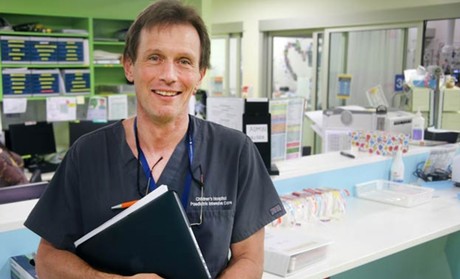New technique a breath of fresh air for kids in emergency

A simple airway therapy trialled by Lady Cilento Children’s Hospital researchers has the potential to become a ‘game changer’ in emergency paediatric medicine.
In a pilot study funded by the Emergency Medicine Foundation (EMF), the researchers found that using a new therapy significantly reduced the risk of complications during intubation (where a flexible tube is inserted in the windpipe).
Dr Andreas Schibler, lead research and a paediatric intensive care specialist at the Lady Cilento Children’s Hospital, said intubating children in emergency departments carried a significant risk of complications.
“In a recent study, it was found that about a quarter of emergency intubations in children don’t succeed on the first attempt,” Dr Schibler said.
“It’s a tricky procedure requiring precise and delicate work, and the conditions in an emergency department are not optimal — and being an emergency, the patient is not fasted and clinically stable like they are for planned intubations in surgery.”
However, when Dr Schibler’s team gave children a supply of warm, humidified oxygen via a thin nasal tube while they were under anaesthesia, the risk of intubation complications dropped sharply. The therapy is known as ‘High Flow Nasal Cannula’ (HFNC), and it can double the amount of time available before blood oxygen levels fall too low.
“We found that using HFNC could significantly improve the odds of successful intubation,” Dr Schibler said.
“As the device is already available in all emergency departments, the process can be easily and cost-effectively introduced in hospitals worldwide, with the potential to significantly reduce healthcare costs.”
Following the promising pilot results, which will be published in the British Journal of Anaesthesia, EMF has granted $280,000 for a larger study at three major Queensland hospitals and additional hospitals around Australia. The trial begins in February 2017.
EMF has invested more than $630,000 in four HFNC trials through its Queensland Research Program, which is fully funded by the Queensland Department of Health.
EMF Chair Associate Professor Sally McCarthy said Dr Schibler’s research was of global importance.
“There is significant interest from emergency physicians around the world in minimising the risks involved in intubating children,” said A/Prof McCarthy.
“Dr Schibler and his team are contributing internationally to knowledge in this emerging field and their research has the potential to lead to major changes in emergency intubation practice.
Dr Schibler also holds an Associate Professor position with The University of Queensland and is head of the Paediatric Critical Care Research Group (PCCRG) at the Lady Cilento Children’s Hospital.
Original article published by Children’s Health Queensland.
High-five for a sustainable path to better hand hygiene
Ahead of World Hand Hygiene Day, an emergency physician explains why hand hygiene is needed all...
Six big ideas for beating brain cancer
The University of Newcastle's Mark Hughes Foundation Centre for Brain Cancer Research has...
All metropolitan public hospitals miss out on green light
AMA's hospital logjam finder uses a traffic light system to indicate care within the...









